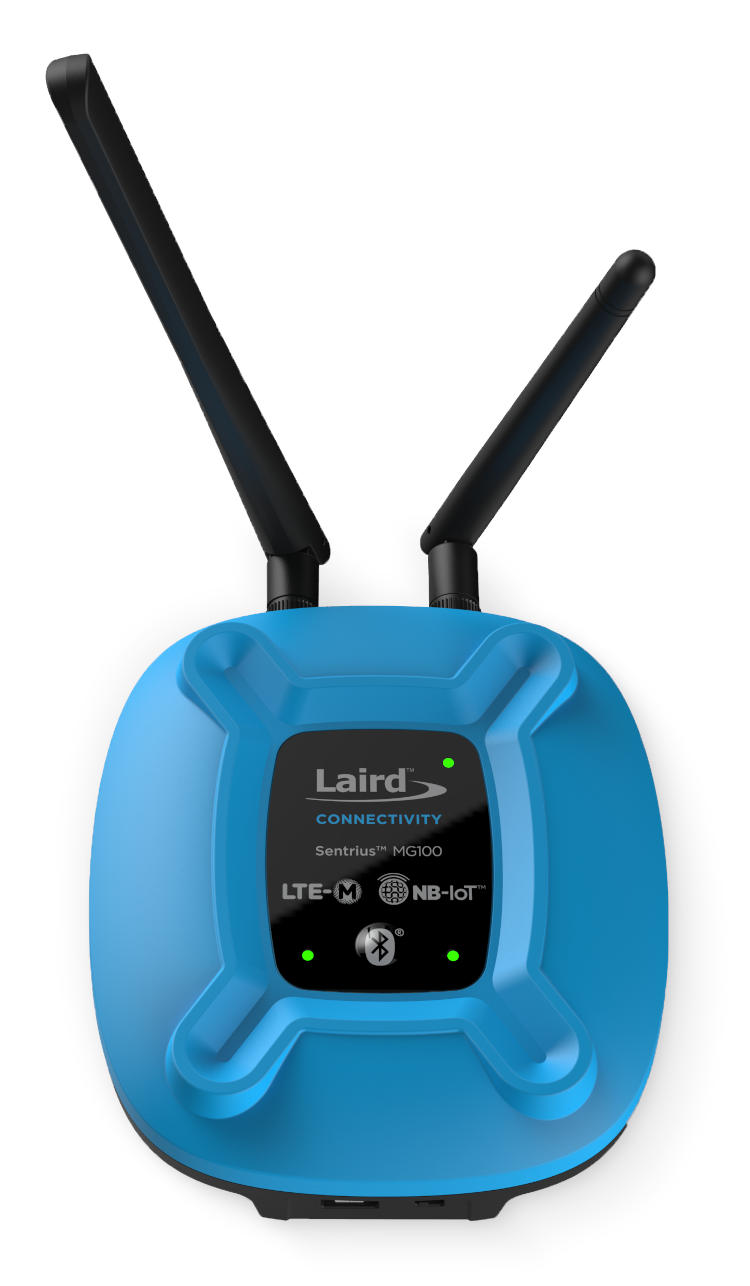Ezurio Sentrius™ MG100 Gateway
Overview
The Sentrius™ MG100 Gateway offers a compact, out of box Bluetooth to low power cellular gateway solution.
Based on the Pinnacle 100 socket modem, the Sentrius™ MG100 gateway captures data from any Bluetooth 5 modules or devices and sends it to the cloud via a global low power cellular (LTE-M/NB-IoT) connection. The MG100 seamlessly incorporates a powerful Cortex M4F controller, full Bluetooth 5 connectivity, and dual-mode LTE-M/NB-IoT capabilities. The MG100 has full regulatory and network certifications and End Device carrier approvals.
Develop your application directly on the integrated Cortex M4F microcontroller using Zephyr RTOS, enabling your application development with a secure, open source RTOS with more than just kernel services. Remotely debug your fleet of devices with the Memfault Platform [5]. Take advantage of the Zephyr community and Ezurio’s Canvas Software Suite [7] to accelerate your development. covering all aspects of the product’s capabilities and hardware interfaces. The MG100 also delivers complete antenna flexibility with internal or external antenna options available, and the optional battery backup provides uninterrupted reporting of remote Bluetooth sensor data.
More information about the board can be found at the MG100 website [1].
The MG100 hardware provides support for the Nordic Semiconductor nRF52840 [6] ARM Cortex-M4F CPU, Sierra Wireless HL7800 [2] and the following devices:
ADC
CLOCK
FLASH
GPIO
I2C
MPU
NVIC
PWM
RADIO (Bluetooth Low Energy and 802.15.4)
RTC
SPI
UART
WDT
QSPI
LIS3DH
HL7800
SD Card

MG100 (450-00054-K1)
Hardware
Supported Features
The MG100 board configuration supports the following hardware features:
Interface |
Controller |
Driver/Component |
|---|---|---|
ADC |
on-chip |
adc |
CLOCK |
on-chip |
clock_control |
FLASH |
on-chip |
flash |
GPIO |
on-chip |
gpio |
I2C(M) |
on-chip |
i2c |
MPU |
on-chip |
arch/arm |
NVIC |
on-chip |
arch/arm |
PWM |
on-chip |
pwm |
RADIO |
on-chip |
Bluetooth, ieee802154 |
RTC |
on-chip |
system clock |
SPI(M/S) |
on-chip |
spi |
UART |
on-chip |
serial |
WDT |
on-chip |
watchdog |
QSPI |
on-chip |
qspi/MX25R64(8MB) |
LIS3DH |
I2C(M) |
sensor/lis3dh |
HL7800 |
UART |
HL7800 modem driver |
SDMMC |
SPI(M) |
SD Card via SPI |
See MG100 website [1] for a complete list of MG100 hardware features.
Connections and IOs
LED
LED1 (red) = P1.7
LED2 (blue) = P1.6
LED3 (green) = P1.5
External flash memory
A 64Mbit external flash memory part is available for storage of application images and data. Refer to the Macronix MX25R6435F datasheet [3] for further details.
The flash memory is connected to the on-board QSPI device controller.
MX25R64 = QSPI
SCK = P0.19 IO0 = P0.20 IO1 = P0.21 IO2 = P0.22 IO3 = P0.23 CSN = P0.17
LIS3DH Motion Sensor
Motion sensor to detect if the gateway moves.
IRQ IO = P0.28 I2C SDA = P0.26 I2C SCL = P0.27
SD Card
SD card used to store large amounts of data.
SPI CS = P0.29 SPI SCK = P1.09 SPI MOSI = P0.11 SPI MISO = P0.12
Programming and Debugging
Applications for the mg100 board configuration can be
built and flashed in the usual way. (see Building an Application
and Run an Application for more details)
The Ezurio USB-SWD Programming Kit [4] contains all the necessary hardware to enable programming and debugging an MG100.
Flashing
Follow the instructions in the Nordic nRF5x Segger J-Link page to install and configure all the necessary software. Further information can be found in Flashing. Then build and flash applications as usual (see Building an Application and Run an Application for more details).
Here is an example for the Hello World application.
First, run your favorite terminal program to listen for output.
Note
On the MG100, the USB connector should be used to access the UART console.
$ minicom -D <tty_device> -b 115200
Replace <tty_device> with the port where the board MG100
can be found. For example, under Linux, /dev/ttyUSB0.
Then build and flash the application in the usual way.
# From the root of the zephyr repository
west build -b mg100 samples/hello_world
west flash
Debugging
Refer to the Nordic nRF5x Segger J-Link page to learn about debugging Nordic boards with a Segger IC.
Software
Canvas Software Suite
The MG100 is a supported hardware platform for Canvas Software Suite [7].
Testing Bluetooth on the MG100
Many of the Bluetooth examples will work on the MG100. Try them out:
